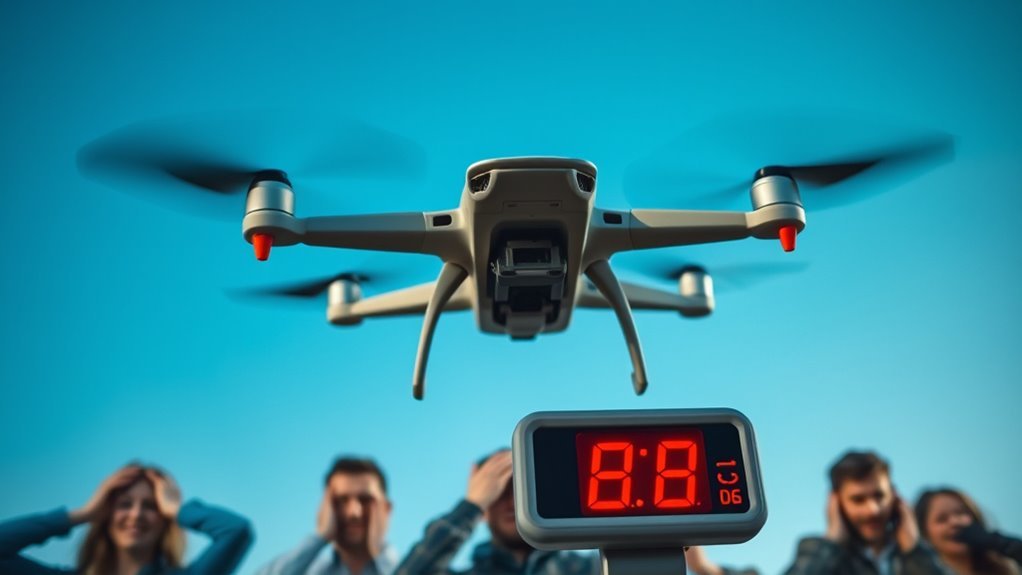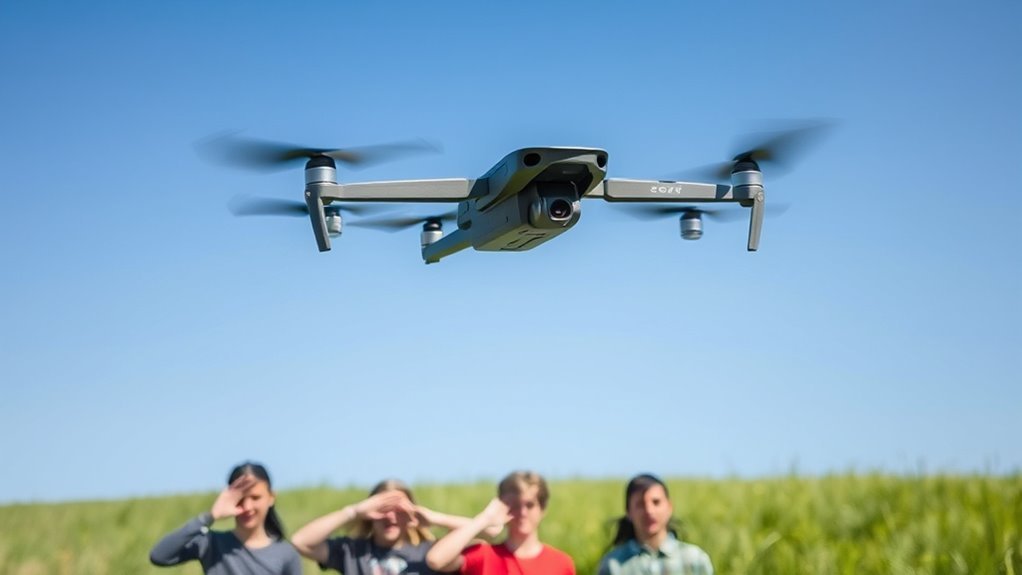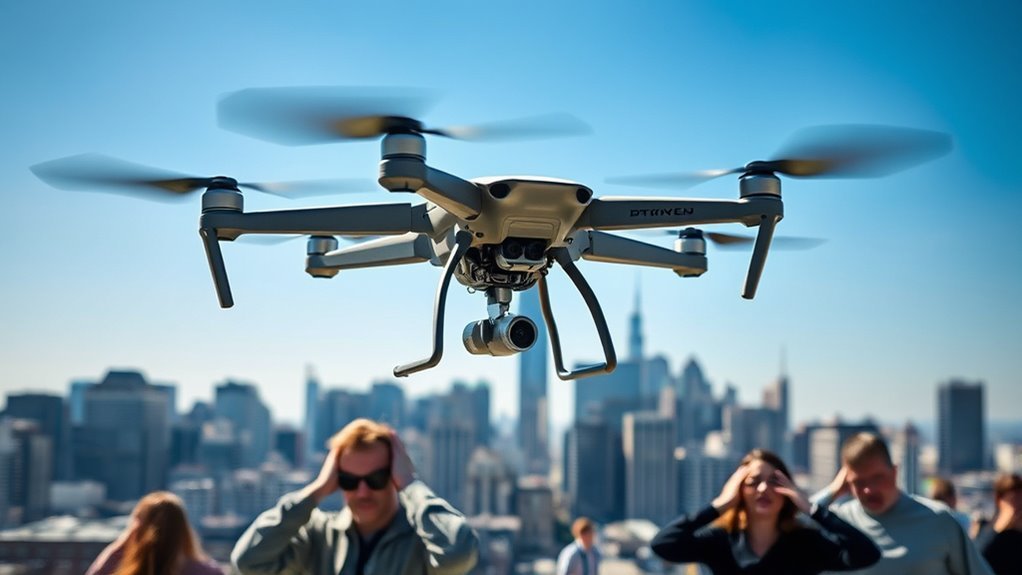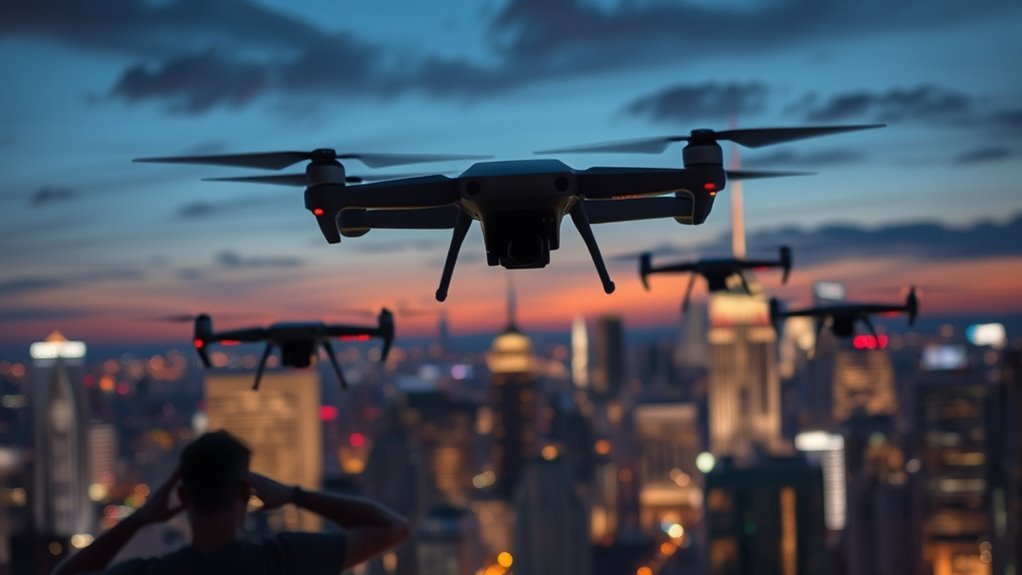You can expect loud drones to produce noise levels between 70 and 90 decibels, similar to heavy traffic or a busy street environment. The exact noise depends on factors like motor type, propeller design, and drone size. Larger drones generally emit lower frequency sounds but can be louder overall due to bigger rotors. Understanding these variables helps you gauge noise impact and informs sound reduction strategies. Exploring these elements reveals how quieter drone operation can be achieved.
Understanding Decibel Levels in Drone Noise

Decibel levels measure the intensity of sound, providing a standardized way to quantify drone noise. When you evaluate drone sound, understanding decibel values enables you to assess its impact on your environment objectively. Noise perception varies among individuals, but decibel readings offer a consistent metric to analyze loudness. For instance, typical loud drones emit sounds between 70 to 90 decibels, comparable to heavy traffic. Recognizing these levels helps you anticipate how intrusive drone noise might be during operation. By relying on decibel measurements, you gain precise insight into sound intensity rather than subjective impressions alone. This technical approach empowers you to balance your desire for aerial freedom with managing noise levels responsibly and maintaining community standards without ambiguity or guesswork.
Factors That Affect Drone Noise Output

You’ll find that propeller design markedly influences the noise signature of a drone, as blade shape and size affect aerodynamic efficiency and sound frequency. Motor power also plays an essential role, since higher power outputs generally increase rotational speed and noise levels. Understanding these factors helps in predicting and managing the overall noise output of loud drones.
Propeller Design Impact
When examining factors that influence drone noise output, propeller design plays a critical role. The propeller shape directly affects aerodynamic efficiency and noise generation; sharper, more streamlined blades tend to reduce turbulence, minimizing sound produced during rotation. Conversely, wider or irregular shapes increase air disturbance, amplifying noise levels. Additionally, blade material impacts vibration and resonance characteristics. Lightweight composites absorb vibrations better, leading to quieter operation, while rigid metals may transmit more mechanical noise. By selecting an optimized propeller shape combined with advanced blade materials, you can greatly lower drone noise emissions without compromising performance. Understanding these design elements empowers you to balance freedom of flight with acoustic discretion, ensuring your drone operates efficiently and discreetly in diverse environments.
Motor Power Influence
Although motor power is essential for drone performance, it directly influences noise levels by dictating rotational speed and torque. When you increase motor power, the motors spin propellers faster, generating higher aerodynamic noise. However, motor efficiency plays a critical role here—efficient motors convert electrical energy into mechanical energy more effectively, reducing excess heat and vibration, which are additional noise sources. Depending on your drone applications, whether for photography or heavy-lift tasks, you’ll need to balance power demands against noise output. High-power motors provide the thrust you need but often at the cost of louder operation. Optimizing motor efficiency allows you to maintain necessary power while minimizing noise, granting you freedom to operate drones discreetly without sacrificing performance. Understanding this trade-off is key to managing drone noise levels intelligently.
Comparing Noise Levels of Different Drone Sizes

Because drone size directly influences rotor dimensions and power requirements, comparing noise levels across different sizes reveals significant variations in sound intensity and frequency. Larger drones typically generate louder noise due to bigger rotors spinning at lower RPMs but producing substantial blade-vortex interactions. Conversely, smaller drones operate at higher RPMs, creating higher-pitched sounds that might be perceived as more intrusive despite lower decibel levels. When you analyze drone comparisons, it’s essential to contemplate how size affects both the acoustic signature and your sound perception. Mid-sized drones often strike a balance, emitting moderate noise levels with less aggressive frequency components. Understanding these distinctions helps you select drones that align with your need for operational freedom while managing noise impact effectively.
How Motor Type Influences Drone Sound
When evaluating drone noise, you’ll find that brushless motors typically generate less audible interference than brushed motors due to smoother operation. The motor’s RPM directly affects the frequency and intensity of the sound produced, with higher speeds generally increasing noise levels. Additionally, motor size plays a significant role, as larger motors often produce lower-frequency sounds that carry differently than smaller, higher-pitched ones.
Brushless Vs Brushed Motors
Motor design fundamentally shapes the acoustic signature of a drone, with brushless and brushed motors producing distinct noise profiles due to their structural and operational differences. Brushed motors, relying on physical contact between brushes and the commutator, often generate more mechanical noise, reducing brushed efficiency and increasing vibrations. This contact friction results in audible clicks and a raspier sound. Conversely, brushless motors eliminate this friction, enhancing brushless durability and enabling smoother operation. Their electromagnetic commutation lowers mechanical noise, producing a cleaner, quieter sound spectrum. When you prioritize freedom in flight with minimal noise intrusion, brushless motors offer superior acoustic performance and longevity. Understanding these differences helps you select a motor type aligned with your noise tolerance and operational demands, balancing efficiency, durability, and sound output for your drone’s intended use.
Motor RPM and Noise
The rotational speed, or RPM, directly impacts the noise your drone produces, interacting closely with the motor type to shape its acoustic footprint. Higher RPMs generally elevate the sound frequency, making the drone’s noise sharper and more penetrating. Efficient motors operate at optimized RPM ranges, balancing thrust and minimizing unnecessary noise emissions. Brushless motors, known for superior motor efficiency, often run smoothly with less mechanical friction, resulting in cleaner sound profiles at given RPMs. Conversely, less efficient motor types may generate additional vibrations and irregular frequencies, contributing to a louder, more complex noise signature. Understanding how motor RPM correlates with sound frequency allows you to anticipate the drone’s acoustic behavior, helping you select motor configurations that align with your freedom to fly discreetly or audibly, depending on your operational needs.
Impact of Motor Size
Although motor size directly affects torque and power output, it also plays a critical role in shaping your drone’s noise profile. Larger motors generally offer higher motor efficiency and enable lower RPM operation, contributing to noise reduction. Conversely, smaller motors may require higher RPMs to generate equivalent thrust, increasing noise levels. Balancing motor size with propeller choice is essential to optimize sound output while maintaining performance and freedom of flight.
| Motor Size (mm) | Efficiency Impact | Noise Level (dB) |
|---|---|---|
| 1806 | High efficiency, low RPM | 65-70 |
| 2205 | Moderate efficiency | 70-75 |
| 2306 | Balanced efficiency | 68-72 |
| 2607 | Lower efficiency, high RPM | 72-78 |
| 2814 | Lower efficiency | 75-80 |
Selecting the right motor size enhances noise control without sacrificing agility.
The Impact of Propeller Design on Noise
When you examine drone noise, propeller design plays an essential role in determining sound levels and frequencies. The choice of propeller materials directly affects vibration and resonance, influencing noise output. Lightweight composites often reduce unwanted acoustic signatures by minimizing structural flex. Aerodynamic efficiency is equally critical; optimized blade shapes reduce turbulent airflow and blade-vortex interactions that generate high-frequency noise. Longer, thinner blades operating at lower rotational speeds tend to produce less noise due to decreased tip vortices. However, balancing aerodynamic efficiency with thrust requirements is key, as inefficient designs demand higher speeds, increasing noise. By understanding how propeller materials and aerodynamic profiles interact, you can select or design propellers that reduce noise without compromising flight performance, giving you greater freedom to operate drones discreetly in various environments.
Measuring Noise: Tools and Techniques for Drones
Since accurately evaluating drone noise is essential for both regulatory compliance and design optimization, you’ll need reliable tools and standardized techniques to measure sound levels effectively. Noise measurement for drones involves capturing precise decibel levels and frequency spectra to understand their acoustic footprint thoroughly. Sound analysis helps identify dominant noise sources, guiding quieter designs without restricting your flight freedom. To get started, consider these essential tools and techniques:
Accurate drone noise evaluation requires reliable tools and techniques for precise sound measurement and effective design optimization.
- Calibrated Sound Level Meters (SLMs) for accurate decibel readings.
- Microphone arrays to capture spatial noise distribution.
- Spectral analysis software to dissect frequency components.
- Controlled environments or open-field testing to guarantee consistency.
Mastering these methods empowers you to assess drone noise objectively and innovate confidently while enjoying unrestricted skies.
Typical Noise Ranges for Consumer Drones
Understanding the typical noise ranges for consumer drones is essential for anticipating their impact in various environments and ensuring compliance with local noise regulations. Most consumer drones produce sound levels between 60 and 80 decibels at a distance of one meter, depending on size, motor power, and propeller design. Acoustic profiling reveals that the drone soundscape is dominated by high-frequency tonal components generated by rapidly spinning propellers, with notable tonal peaks typically between 1 and 4 kHz. Smaller drones tend to emit less overall noise but higher-pitched sounds, which can be more perceptible over background noise. By analyzing these typical noise ranges, you can better understand how your drone interacts acoustically with its surroundings, enabling more informed decisions about flight locations and times to minimize disturbance while preserving your freedom to operate.
Noise Regulations and Drone Operation Limits
The noise characteristics of consumer drones directly influence the regulatory frameworks that govern their operation. To maintain regulatory compliance, you must understand the operational limits imposed by noise regulations, which vary by region but generally aim to minimize disturbance. These constraints affect when, where, and how you can fly your drone, balancing freedom with responsibility.
Consider these key points:
- Maximum allowable noise levels often dictate flight zones and altitudes.
- Time-of-day restrictions reduce noise impact during sensitive hours.
- Special permits may be required for louder drones or specific activities.
- Noncompliance risks fines and operational bans, limiting your drone’s usability.
Strategies to Reduce Drone Noise Pollution
To effectively reduce drone noise pollution, you need to focus on propeller design improvements that minimize aerodynamic noise by optimizing blade shape and rotation speed. Additionally, flight path optimization can help you avoid sensitive areas and reduce noise exposure to people on the ground. Combining these strategies allows for a targeted approach to lower overall sound levels without compromising drone performance.
Propeller Design Improvements
Although drone noise often stems from multiple sources, propeller design plays a critical role in controlling acoustic emissions. You can markedly reduce noise by focusing on propeller materials and propeller shape. Advanced composites absorb vibrations better, while optimized shapes minimize aerodynamic disturbances. Consider these improvements:
- Use lightweight, vibration-damping propeller materials to reduce mechanical noise.
- Design blades with swept or tapered shapes to lower tip vortex noise.
- Increase the number of blades to distribute load and decrease pressure fluctuations.
- Employ variable pitch mechanisms to maintain efficient rotation at varying speeds.
Flight Path Optimization
When you optimize flight paths, you can considerably reduce the noise impact drones have on populated and sensitive areas. By carefully planning routes that avoid residential zones, schools, and hospitals, you minimize noise exposure to those seeking peace and freedom from disturbance. Employing altitude adjustments further aids noise reduction; flying higher decreases sound intensity on the ground due to atmospheric attenuation. Additionally, selecting flight paths that leverage natural terrain to block or absorb sound enhances noise mitigation. Integrating real-time environmental data allows dynamic route adjustments, ensuring noise-sensitive locations remain protected. By prioritizing flight path optimization, you maintain operational flexibility while respecting community noise thresholds. This strategic approach empowers you to balance drone functionality with responsible noise management, fostering coexistence between advanced aerial technology and the freedom of quiet spaces.
Future Trends in Quieter Drone Technology
As drone applications expand across industries, quieter technology is becoming essential to meet regulatory standards and community acceptance. You’ll see innovations focused on silent propulsion systems, reducing noise without sacrificing power. Advanced materials are being engineered to dampen vibrations and minimize acoustic signatures. Here are key trends shaping the future:
- Integration of silent propulsion technologies to drastically cut rotor noise.
- Use of advanced materials that absorb sound waves and reduce mechanical noise.
- Aerodynamic redesigns that optimize blade shape for quieter airflow.
- Implementation of active noise cancellation systems in drone chassis.
These advancements empower you to operate drones more freely, respecting noise-sensitive environments while revealing new possibilities in urban and rural settings. The future promises quieter skies and expanded drone freedom.

